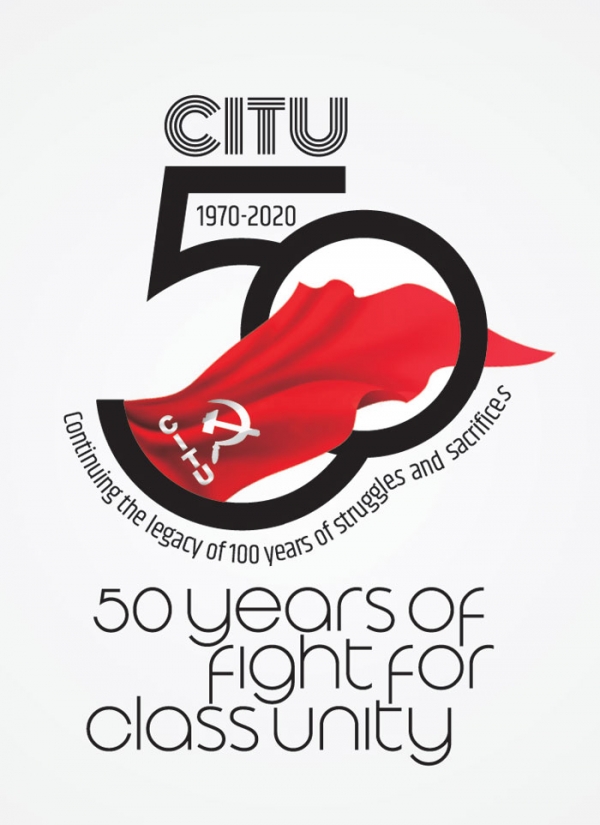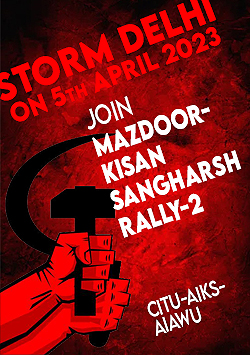On this, Lenin wrote, “The infamous sentence pronounced by the British jackals on the Indian democrat Tilak…this revenge against a democrat by the lackeys of the money-bags evoked street demonstrations and a strike in Bombay. In India, too, the proletariat has already developed to conscious political mass struggle – and, that being the case, the Russian-style British regime in India is doomed!” [“Inflammable Material in World Politics”; July 23 (August 5), 1908]
II
A CHAIN of events after the World War I led to the rapid formation of organised trade unions and the first trade union centre. These were -
- World War I resulted in grave economic miseries of the Indian working class by way of price rise, low wages, long hours of work and other exploitative measures which led to serious industrial unrest and agitation.
- Great October Revolution 1917 and formation of first Working Class State in human history galvanised the working class movement and national liberation movement worldwide, including India.
- Jallianwala Bagh massacre, Rowlatt Act, imprisonment of national leaders and heightened freedom struggle by Home Rule Leagues in 1915, Rowlatt Satyagraha in 1919, Non-Cooperation and Khilafat Movements in 1920-22 also led to resurgence of working class activity in that period.
- The Great October Revolution and worldwide working class resurgent movement consequently established the tripartite international labour forum of the League of Nations (now a UN agency) – the International Labour Organisation (ILO) in 1919.
- The first modern trade union was formed as Madras Labour Union in 1918 in Buckingham and Karnatic Mills, led by B. P. Wadia, an associate of Annie Besant; with 1600 members in its roll, and organizational set up and leadership team.
- Gandhiji formed Ahmedabad Textile Labour Association also in 1918 with Gandhian economic thought of ‘Trusteeship’ between capital and labour for ‘class peace’ and ‘class collaboration’.
- Rapidly, trade unions developed in industrial centres, mostly in Bengal, Madras and Bombay provinces and in shipping, railways, communications, jute, coal, textiles and engineering industries. The workers were restive and strike struggles were sweeping the country.
- In the absence of a national body of the unions, the British ruled Government of India nominated N.M. Joshi to represent Indian trade unions in ILO. Many unions protested. Ultimately, it was decided to resolve the dispute by forming an all India body of the trade unions.
THUS, the first all India trade union centre was formed as the All India Trade Union Congress (AITUC) in a conference in Bombay on 31 October, 1920 attended by 101 delegates representing 64 unions with 1.40 lakh members. 43 more unions expressed solidarity. A number of political leaders and fraternal delegates from British Trade Union Congress also attended. The meeting elected Lala Lajpat Rai as its President and N. M. Joshi as its General Secretary. The entire leadership, obviously, came from the Indian National Congress. The nascent working class party of India – the Communist Party of India – was just formed at Tashkent on 17 October, 1920.
III
YET, there were two currents in this newly formed trade union centre (TUC). The two currents were best reflected by the textile workers – one in Bombay led by the Girni Kamgar Union going for militant strikes and class struggles going beyond immediate economic demands and for basic policy changes; and the other led by Ahmedabad Textile Labour Association going for class collaboration (reformism) limited to some instant economic issues. These two currents continued to plague AITUC.
- The trade union movement and national freedom struggle juxtaposed, heightening both in the period after formation of the TUC. Strike struggles were sweeping across the country. In 1921 alone, about 400 strikes took place. More than half of those were successful. Freedom movement raised its demand from ‘dominion status’ to ‘Purna Swaraj’, first raised by the Communist party and the trade unions led by them.
- For the first time in India’s history, to celebrate May Day, the International Working Class Solidarity Day, the red flag was raised by Malayapuram Singaravelu Chettiar on 1 May 1923 in Chennai.
- To split the unity of the working class; to isolate the revolutionaries of the freedom movement, who were working in the trade unions and leading workers strikes; and also to control the sweeping strike actions; the British Government in India introduced Trade Union Act, 1926 by which the identity of the leading functionaries and obtaining written permission, as certificate, from the British rulers, became compulsory for any trade union activities including in conducting the strike.
- In 1928 the Simon Commission arrived for ‘constitutional amendments’ instead of ‘Purna Swaraj’. Call of ‘Simon Commission Go Back’ reverberated across the country; workers resorted to strikes and staged black flag demonstrations particularly in Bombay, Calcutta, Madras and Lahore. While protesting at Lahore, Lala Lajpat Rai, the first President of AITUC, was killed by police lathi charge. He died on 17 November, 1928; and Saunders, the British police officer who had led the lathi charge, was killed in retaliation by the revolutionaries on 17 December, 1928.
- To put a stop to the waves of workers strikes (316 lakh man-days lost due to strikes in 1928) and their involvement in the national freedom struggle, the imperial government introduced ‘Trade Disputes Bill’ and ‘Public Safety Bill’ 1928 together having repressive provisions. While the Trade Disputes Act was being debated in the Central Assembly on 8 April, 1929, “There was an explosion in the Assembly and suddenly the Hall was filled with smoke and slogans rose in loud voice by two young men from the Visitors’ Gallery. The three slogans raised many times over were -‘Inquilab Zindabad’, ‘Down With Imperialism’ and ‘Workers of the World Unite’.” (JNU Prof. Chaman Lal in the Mainstream Weekly, 2009). They were Bhagat Singh and Batukeshwar Dutta. The rest is history.
‘Inquilab Zindabad’, since then, became the war cry of the working class in India to go forward in the blazing path of class struggle.
- Again, to divide the trade unions organizational unity, isolate the communists from it and to suppress the militant trade union movement joining the national freedom struggle; the imperialist government instituted ‘Cawnpore Communist Conspiracy Case’, 1924 in which Muzaffar Ahmad, S. A. Dange and others were sent to prison.
Yet, the communist influence became stronger in the trade union movement. The British Government struck again in 1929, arresting 31 trade union leaders including two workers of Girni Kamgar Union and British nationals, who stood in international solidarity with Indian working class movement. For minimum publicity, the Government held four and a half year long trial in remote place at Meerut, which is known as Meerut Trial, against allegation of attempt to overthrow British imperial government by inciting the working class.
Despite the British government’s attempt of minimum publicity, this trial brought countrywide huge protests and international condemnation from celebrities such as Albert Einstein, Romain Rolland, H. G. Wells, the Archbishop of York, Harold Laski. Then the failed government launched an all out offensive declaring the Indian Communist Party illegal on 23 July 1934. This made more than a dozen registered trade unions also illegal as per the Trade Union Act, 1926.
- Thousands of Royal Indian Navy ratings went on strike on 18 February, 1946 in Bombay. They lowered the Union Jack and hoisted Congress and Muslim League flags and came out on the street. Workers went on spontaneous strike and joined them. They were also joined by ordinary people raising slogans against the British government and saluting by ‘Jai Hind’. They were quickly joined by naval revolt in other parts – in Calcutta, Madras, Karachi and Vizag. Earlier, there were protests in Royal Indian Air Force also. Both signaled the end of British Raj in India.
Though massively supported by the workers and the people, both the parties – Congress and Muslim League – refused to support the naval ratings and asked them to return to their duties. History was unmade.
IV
HISTORY of Indian trade union movement is replete with splits and unity efforts. Communists in the trade union movement always stood for trade union unity as the pre-requisite condition for working class unity, the historical force of social change; remaining firmly committed to class struggle as the working class weapon for this social change. They never compromised with reformism in the trade union movement. Hence, the “Unity and Struggle” became the essence of the trade union movement.
FIRST divisions and unity: (1930-1940)
- Soon after British government launched the Meerut Trial against communists as trade union leaders; the reformists led the first split in AITUC in its Nagpur session in 1929 and formed the Indian Trade Unions Federation (ITUF) in 1930.
- The specific condition created, after Meerut Trial began, in the trade union movement and the attitude of the reformists, was best explained by Abdul Halim, the main organiser of communist movement in Bengal after arrest of Muzaffar Ahmad in the Meerut case, in his book ‘Task of the Left-Wing Trade Unions of India’, published in 1929. In such conditions, Red Trade Union Congress (RTUC) was formed, separating from AITUC in 1931.
- Amalgamation of ITUF and AIRF (All India Railwaymen’s Federation) gave rise to National Trade Union Federation (NTUF).
- RTUC merged with AITUC in 1934.
- NTUF became affiliated to AITUC in 1938 and then merged in its conference at Nagpur in 1940.
SECOND divisions (1947-1970)
- Just 3 months before Independence, the Congress party engineered a split in AITUC at the behest of Sardar Vallabhbhai Patel and formed the Indian National Trade Union Congress (INTUC) in 1947 “to extend their influence over the working class and fight the communists as the main enemy…wanted a policy of class-collaboration..” “In his presidential address, Sardar Patel said, ‘The irresponsibility and recklessness of these people pass all understanding. Strikes are launched on all conceivable pretexts in utter disregard of the workers’ own interests and well being. Nothing is achieved through these strikes except chaos and misery all round’.” (Quote from BTR’s writing).
- This was followed by the formation of Hind Mazdoor Sabha (HMS) in 1948;
- United Trade Union Congress (UTUC) was formed in 1949, which itself was split in 1958; and
- The separated group as UTUC (LS) was formed in 1958 (later renamed as AIUTUC);
- Bharatiya Mazdoor Sangh (BMS), affiliated to RSS, was formed in 1955.
FORMATION of CITU
- In this background the Centre of Indian Trade Unions (CITU) was formed in 1970 with the call of “Unity and Struggle”.
The historic milestones of its journey since then were detailed in our previous issue.
J. S. Majumdar



